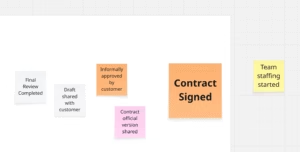Pivotal Events
In EventStorming, Pivotal Events act as splitters between distinct phases of the business flow.

Pivotal Events act as splitters of the main EventStorming narrative.
They are instrumental in building a structure for the many narrative of a business flow, and provide information that later may be useful in decomposing the system.
Detecting Pivotal Events
During the enforce the timeline step of a Big Picture EventStorming, we might ask the audience for common events that look like good splitters between different phases. Events with a clear distinction between before and after.
We might pick the key moments of the overarching business transaction, like Contract Signed, Payment Received, Item Delivered, etc.

Duplicated or overlapping events may signal a Pivotal Event.
The number of duplicate sticky notes might also provide insights. Different participants’ narratives tend to converge on the same events.
The precise wording may be different (and interesting to investigate), but a cluster with compatible interpretations probably signals an event on a responsibility boundary.
We won’t usually spend much time in the detection phase. We don’t have enough information yet to look for perfection. We need plausibility and a balanced distribution of the areas between the Pivotal Event.
An event at the very beginning or the very end is not a good candidate for a Pivotal Event; a splitter needs to be somewhere in the middle.
Marking Pivotal Events
During in-person workshops, we usually highlight Pivotal Events with a paper tape. This allows for replacing and rearranging if new insights emerge during the discussion.

Larger sizes and bold fonts should do the trick online.
Note: In online workshops, we use a larger size and bold font to differentiate pivotal events from the standard ones. We often use different colours during the initial exploration, using orange to signal that an event has been discussed/accepted.
Whatever the chosen notation, it should be easily reversible. Pivotal Events aren’t precise yet.
Once the first Pivotal Events are highlighted, we try to rearrange the remaining events to be coherent with the new dominant narrative.
This rearrangement process often leads to more refinements in the flow structure, such as more splitters and horizontal swimlanes.
Refining Pivotal Events
The original detection phase is fast, meaning that we are trading precision for plausibility. We need to get into a workable structure quickly, and the initial Pivotal Events candidate may require a few rearrangements or rewritings before approval.
You may find events describing the same concept at different levels of precision, or displaying nuances which may be worthy of a deeper discussion.
Don’t expect to finish the workshop with the same Pivotal Events you selected in the kick-off stages.
Consequences
- Pivotal Events are very likely to mark boundaries between Bounded Contexts.
- Pivotal Events are good candidates to become Public Events, part of an Event-Driven Published Language (see Context Mapping) between the different Bounded Contexts in a system.